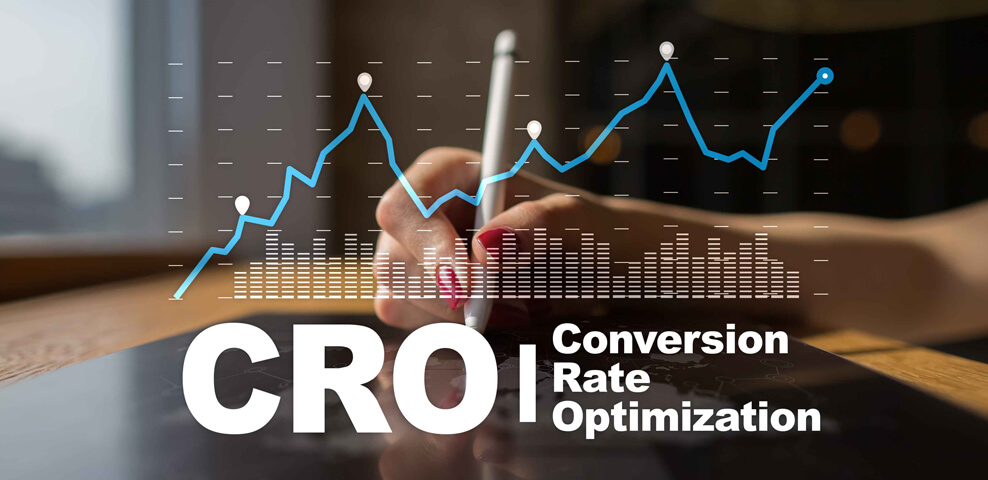“The best way to predict the future is to create it.” – Peter Drucker
Businesses are always looking for ways to outperform the competition and increase income in today’s uber-competitive business environment.
In such a situation, Conversion Rate Optimisation (CRO) can prove to be your hidden weapon, a compass pointing you in the direction of more sales and enhanced online performance.

As Peter Drucker eloquently observed, anticipating the future necessitates taking proactive measures, and CRO is one such measure that enables businesses to control their digital future.
What is Conversion Rate Optimisation?
- Conversion rate optimisation (CRO) is a methodical process for increasing the percentage of website visitors who complete desired actions, including buying something, completing a form, or subscribing to a newsletter.
- Essentially, CRO focuses on increasing the effectiveness and profitability of your website by converting inactive users into active clients.
The CRO Blueprint
Following a strategic blueprint that defines the processes for optimisation is essential if you want to fully realise the potential of CRO.
1. Data-Driven Analysis
- Start by data driven analysis as examining user data to spot trends and pain points.
- Recognise user behaviour, including the pages they visit, their length of stay, and their exit points.
2. Setting Clear Goals
- Establish precise objectives for your CRO campaign, such as a 20% increase in sales during the upcoming quarter.
- Your optimisation efforts will have a clear focus and direction if you set clear goals.
3. Developing Engaging Content
- Create persuasive and compelling content that appeals to your target audience.
- Make use of graphics, emotional cues, and storytelling to connect with your audience.
4. Streamlining User Experience
- Make sure the user experience is seamless and simple on all platforms.
- Reduce page load times, streamline navigation, and get rid of any conversion barriers.
5. A/B Testing
- Try out different versions of important elements, including layouts, call-to-action buttons, and headlines.
- A/B testing makes it possible to determine which modifications result in higher conversion rates.
6. Personalisation
- Adapt your content and offers to the distinct preferences of various user categories.
- User engagement can be increased by personalisation, and conversion rates can be improved.
7. Building Trust and Credibility
- To build credibility, highlight social proof, client testimonials, and trust badges.
- Address user concerns and objections upfront to alleviate doubts.
8. Analysing and Iterating
- Analyse data to continuously check the effectiveness of your CRO strategies.
- Refine your tactics and make data-driven decisions using the newfound insights.

The Impact of CRO on Sales
A strong CRO strategy can result in a number of tangible advantages that can directly boost sales and revenue, including:
1. Improved Conversion Rates
Increasing the conversion rate of your website results in more potential for sales.
2. Superior Customer Experience
Positive customer experiences, which promote repeat purchases and brand loyalty, are fostered through a fluid and user-friendly website.
3. Cost-effectiveness
CRO increases the value of already-existing website traffic rather than spending significant resources on acquiring new consumers.
4. Informed Decision-making
CRO activities provide data-driven insights that aid in making marketing choices that are appealing to the target market.
Are you prepared to drastically improve your online performance and see your sales soar? Join forces with IKF, a renowned digital marketing company in India.
Utilising the power of Conversion Rate Optimisation (CRO) to take your business to new heights is Team IKF’s area of expertise. Get in touch with us today to start your journey!
FAQs
1. What does CRO conversion rate optimisation help for?
CRO (Conversion Rate Optimisation) helps businesses enhance their website’s effectiveness in turning visitors into customers. By optimising various elements like content, design, and user experience, CRO increases the likelihood of achieving desired actions such as purchases, sign-ups, or inquiries.
2. How have you used conversion rate optimisation (CRO) techniques to improve campaign performance?
Conversion Rate Optimisation (CRO) techniques involve analysing user behaviour, testing various elements, and refining strategies to improve campaign performance. These methods ensure that campaigns resonate better with the audience, resulting in higher conversion rates and improved overall success.
3. How can sales conversion rates be improved?
Sales conversion rates can be improved by implementing effective Conversion Rate Optimisation (CRO) strategies, such as refining website design, crafting compelling content, and using persuasive call-to-action elements. Additionally, personalised user experiences, streamlined navigation, and addressing customer pain points directly contribute to boosting conversion rates.
4. How do you increase conversion rate optimisation?
Conversion rate optimisation (CRO) entails identifying user pain points through analysis of user data, conducting A/B testing on various elements, and then making adjustments to the content and user experience in light of the results. To increase conversion rates, personalised techniques must be used along with trust-building and continual iteration based on data-driven choices.
5. What are examples of conversion optimisation?
Examples of conversion optimisation include modifying the design and placement of call-to-action buttons, testing different variations of landing page headlines, and simplifying the checkout process to reduce friction. Additionally, offering personalised product recommendations based on user behaviour and showcasing social proof can also contribute to improved conversion rates.

Ashish Dalia is the CEO & Chief Digital Marketing Strategist at I Knowledge Factory Pvt. Ltd.

Ashish Dalia is the CEO & Chief Digital Marketing Strategist at I Knowledge Factory Pvt. Ltd.











